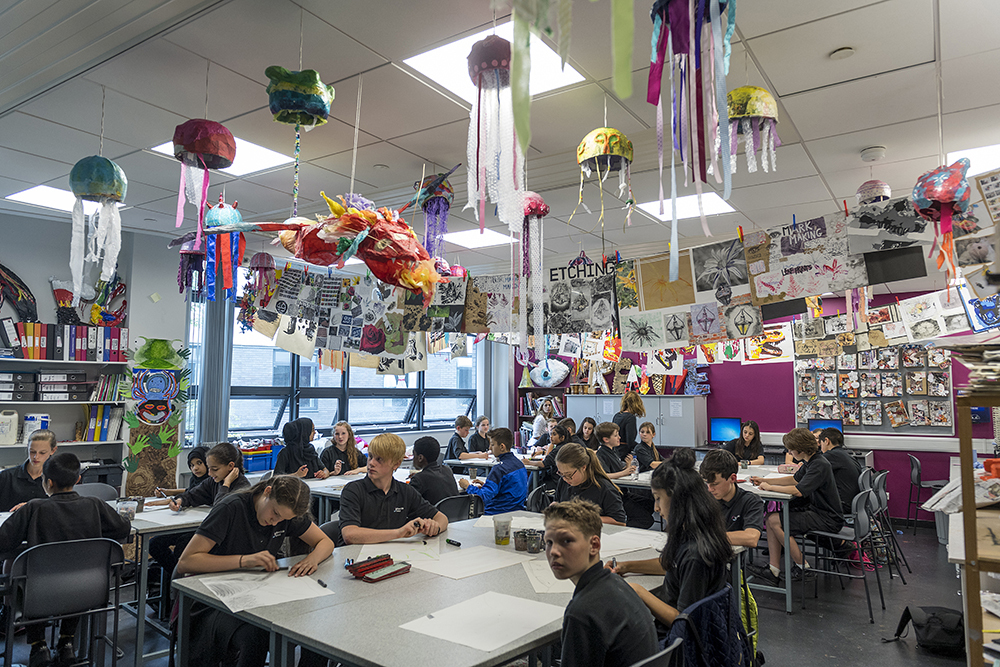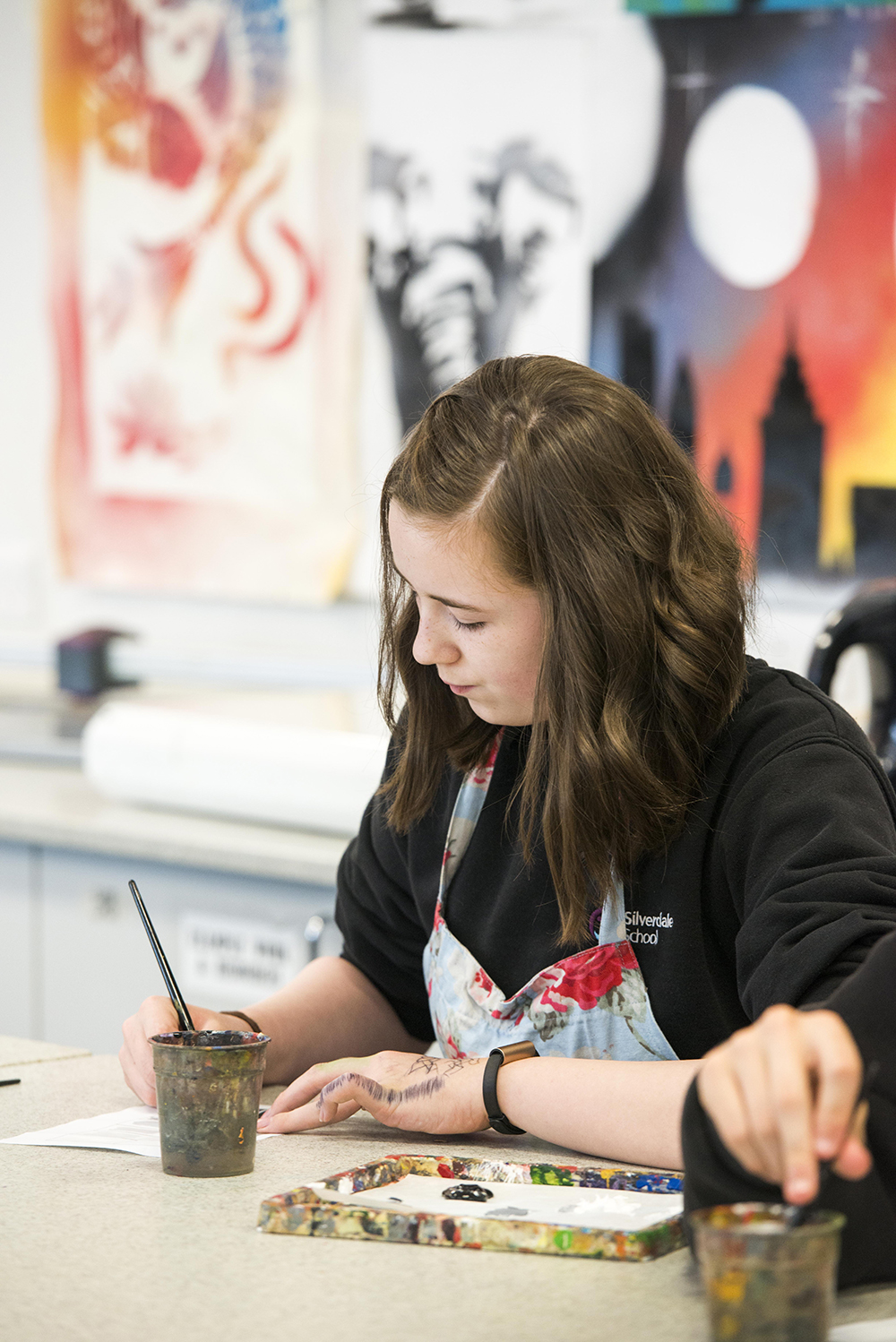Art and Design
 The Art Department strives to ensure each student gains a foundation knowledge of art that is mapped using assessment objectives with creativity, diversity, and independence threaded through at every point. These core values support our students to confidently navigate the curriculum. We aspire to shape students that can work independently and that have the confidence to self-direct their own learning through the power of coaching, guidance, and mentoring. These fundamental aspects of our curriculum endeavour to build creative resilience and encourage passion and enthusiasm for the subject. Woven through the course is a constant appreciation for art and its impact within a rich and diverse school curriculum and its place in a wider world context.
The Art Department strives to ensure each student gains a foundation knowledge of art that is mapped using assessment objectives with creativity, diversity, and independence threaded through at every point. These core values support our students to confidently navigate the curriculum. We aspire to shape students that can work independently and that have the confidence to self-direct their own learning through the power of coaching, guidance, and mentoring. These fundamental aspects of our curriculum endeavour to build creative resilience and encourage passion and enthusiasm for the subject. Woven through the course is a constant appreciation for art and its impact within a rich and diverse school curriculum and its place in a wider world context.

Why choose to come to our school for this subject?
Our department offers an exciting, broad, and diverse art experience. Our students explore a concept through the medium of paint, mixed media, various printing techniques, ink, photography and film and textiles, coupled with the opportunity to make large scale sculpture and installation. This year we are excited to be moving in our purpose-built art rooms in the extended building. Part of this expansion includes a new kiln room, drawings tablets and more space, meaning we can deliver an even more diverse curriculum.
Schemes of learning have been developed with cultural capital in mind to enable our students to work with, question and challenge artwork beyond the classroom. Making links to relevant concepts and global issues supports students with understanding the context of their own learning. Our students rise to the challenge and, as a result, we have an exciting range of independently creative and diverse responses to projects starting in key stage 3 and developing in depth through and GCSE and A-Level.
These diverse opportunities are delivered by our enthusiastic, cohesive, and knowledgeable staff enabling our students succeed and go on to study in a creative environment. Our multi-skilled team have expertise and industry experience in fine art, ceramics, sculpture, installation art, textiles, jewellery design, metal work and photography. Our art staff are considerate of student wellbeing and take steps to individualise learning. These steps include twilight sessions which provide space for students to reflect on their work and progress in a calm working environment.
We aim to give students the opportunity to undertake artist workshops, visit galleries and attend trips to widen their experience and knowledge of materials, techniques, and processes. The students have commented this makes them feel more confident in their own creative processes and willing to take risks with their own aesthetic. Experience tells us that working in this way gives our students consistently excellent results.
in Year 7
The Formal Elements of Art – Animals. Students will explore:
- Line, tone, form, colour, pattern and texture
- Beginning to learn how to sketch and draw in proportion
- Using pencil to create tone and applying pattern and texture
- Observational drawing
- Beginning to learn a basic understanding of the colour wheel
- Producing a personal outcome
3D project, making hot air balloons and air ships. Students will explore:
- 3D modelling skills using papier mache to create a hot air balloon
- Exploring artists
- Travelling the world and exploring cultures
- Ending in students creating a personal and informed outcome
Landscapes or the World. Students will explore:
- Learning about the fundamentals of landscape drawing
- Drawing from life
- Large scale drawing with graphite
- Exploring artists
- Ending in students creating a personal and informed outcome
- World landscape African, climate etc
Self-directed/student led project that will:
- Allow students to implement what they have learned during the year and make choices about what they would like to do and how to develop their own work
- Provide students with the tools to get used to working independently, ready for GCSE and A-Level
In Year 8
Formal Elements of Art – World Food. Students will explore:
- Line, tone, form, colour, pattern and texture, recapped from Y7 but with a focus of food and with increasing complexity
- A more comprehensive understanding of the colour wheel
- Observational drawing
- How artists work
- Using oil pastel
- Working in large scale,
- Ending in students creating a personal and informed outcome
Natural Forms and Print (Natural forms around the world). Students will explore:
- How to develop a project, building on skills and outcomes, using the work they have produced to inform the next steps
- Large scale drawing
- Observational drawing from life
- How to make a Polyprint
- Mark making using natural forms
- How Artists work
- How to make and print a collagraph print
Wild Beasts 3D project. Students will explore:
- How artists work and illustrate wild beasts
- Drawing beasts, applying the formal elements
- Using cardboard effectively to build 3D elements
- Cardboard manipulation
- Creating a large beast headpiece with elements taken from their discoveries throughout the project
Self-directed/student led project that will:
- Allow students to implement what they have learned during the year and make choices about what they would like to do and how to develop their own work
- Provide students with the tools to get used to working independently, ready for GCSE and A-Level
In Year 9
The origins of Graffiti and stencil art, with a focus on the Formal Elements of Art. Students will explore:
- Building on their knowledge from Y7 and Y8 students will explore graffiti art whilst applying all the formal elements of art
- How artists work
- How to draw character drawings
- Using pen and water
- Mixing colour
- How to create a stencil
Faces of the World. Students will explore:
- Drawing portraits in proportion
- The techniques of portrait drawing and painting.
- Self-portraits, culture, diversity and techniques to help realise a range of possibilities.
- Artist Annette Tjærby Manege
- Cultural differences within portraiture
Paper cities 3D project. Students will explore:
- Drawing buildings, learning about proportion, tone and detail
- How artists work
- Making 3D buildings using paper and card
- The cultural differences of cities and buildings
- Working collaboratively to create class “cities”
Self-directed/student led project that will:
- Allow students to implement what they have learned during the year and make choices about what they would like to do and how to develop their own work
- Provide students with the tools to get used to working independently, ready for GCSE and A-Level
GCSE ART and design (fine art)
(AQA EXAM BOARD)
What will you learn?
You will learn to, independently, develop and create projects within themes of your own choosing, producing a wide variety of art work that meets four assessment objectives and culminates in a final outcome.
You will explore the formal elements through drawing, painting, photography, print-making, digital manipulation, and 3D work. Technique workshops vary each year, but may include learning to use acrylic paint, pencil, pen, watercolour, screen printing, etching, photography, and mod-roc construction.
GCSE students are given much more freedom and make their own choices over the materials they want to use, subject matter, project titles and how they would like to develop their work.
How will this be assessed?
Each project is assessed according to four assessment objectives, and you will be regularly assessed to help you to monitor your progress. There is a deadline for each objective during the year and your work for that objective will be assessed at that time to keep you up to date with your progress.
There are two components to the course. Component 1 consists of workshops and two, self-directed projects, making up 60% of your mark. Component 2 is an externally set assignment worth 40% of the final mark. This will begin on January 1st in Year 11 from a range of starting points issued by the exam board.
beyond the classroom
Our extra curricular activities are constantly expanding and developing. Breaking beyond the boundaries of the classroom equips our students will the skills and knowledge to record from life, build connections to artworks and understand how to interpret art and their world. We strive to deliver a diverse and exciting range of experiences starting from key stage 3 in the form of clubs, artist workshops, competitions, sketch crawls, gallery and museum visits. For example, this year as part of activities week we took a group of students to the Van Gogh immersive experience in York.
Post pandemic has allowed us to reignite residential trips for key stage 4 and key stage 5. This year we have taken a group of GCSE students to the award-winning Conway Centre in Anglesey. Here students were able to work with a range of practising artists over a weekend to developing a body of work which contributed to their GCSE coursework. The students took great pride in the work they created, and we were able to celebrate this with their friends and family via an in-school exhibition of the work. We are now developing on this experience to deliver an even more exciting programme of workshops and sketch crawls in Hartington for our next cohort.
With more time given to the specialism at A-level we take the opportunity to incorporate more outside learning experiences. These include visits to Sheffield Hallam University where students experience life drawings and exhibition openings. We utilise our location to plan sketch crawls in both the peak district and Sheffield city centre. Students draw, take photographs, and observe the contrasting environments. Previously we have taken students to explore the incredible culture, galleries, and street art in London on a residential trip. Next academic year we will be travelling abroad to Paris where students can immerse themselves in the historical city of art. In visiting the Louvre, Pompidou, Musée d’Orsay and Eiffel Tower we hope that students will appreciate the diversity of this culture. We see the impact of these experiences in the way students work becomes more personalised.
Future pathways
Many of our students from GCSE go on to study A-level with us. Of these students at A-level, many go on to study Foundation Art at Chesterfield, preparing them for BA study at prestigious universities throughout the country.
Our alumni include students who have gone on to work for Disney/Pixar and BMW in Germany.
There are many opportunities for students who have studied art at GCSE and A-level, with many universities seeing a creative subject as the basis for problem-solving in degree subjects. Subjects which may not have traditionally had links to creative skill sets are finding their art portfolios are warmly received for careers in subjects like Engineering. Almost all universities accept Art as an A-level for UCAS application, and the portfolio of work produced is a welcome addition at interview to show a range of skills and strengths of the candidate.
